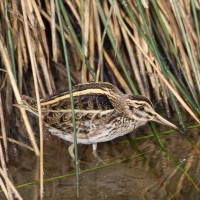Beschreibung
The river Plym Estuary is an important area for wintering birds. It houses wintering populations of Seidenreiher, Grünschenkel, Schwarzkopfmöwe, Polarmöwe, Eismöwe, Säbelschnäbler, Mittelsäger, Großer Brachvogel and Rotschenkel. But many other birds can be seen, see the birdlist below.
Details
Zugang
The estuary is surrounded by roads and footpaths. It is easily watched and has parkland on it's eastern side. It's South side is best during sunny days, avoiding glare off exposed mud/water. The high water roost is at it's North Eastern end, for those with limited time and wanting to visit the high water roost only use Coypool Park & Ride (Free - marked with P and Star on map). If you want to walk around the entire estuary, that's a distance of 7 km. Click on the P's on the map to get directions.
Terrain und Habitat
Vereinzelte Bäume und Büsche , Grasland, Wiesen , Feuchtgebiet , Fluss , Meer , Schlammflächen , Stadt/Dorf , WaldBedingungen
Flach , Offene Landschaft , Hochwasser möglichRundweg
JaIst ein Spektiv nützlich?
Möglicherweise hilfreichGute Beobachtungszeit
GanzjährigBeste Beobachtungszeit
Frühjahrszug , Herbstzug , Herbst , Frühjahr , WinterRoute
asphaltierte Straße , Normaler Weg , Schmaler PfadSchwierigkeitsgrad der Tour
EinfachErreichbarkeit
zu Fuß , Fahrrad , Auto , RollstuhlBeobachtungshütten oder -türme
JaZusätzliche Informationen
Recently the National Trust who own Saltram Park have closed off access to the embankment that holds the high water roost at Blaxton Meadow (or Blaxton Marsh/, please DO NOT walk on this embankment as this has a major effect on wintering birds.
NB, Blaxton Meadow (or Marsh) is not to be confused with Blaxton Creek, which can be found on Lopwell Dam and Tavy Estuary (see separate entry).




